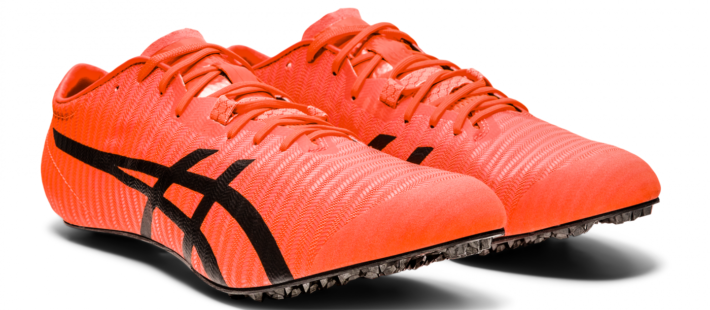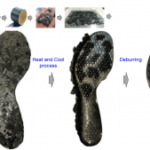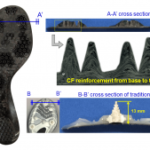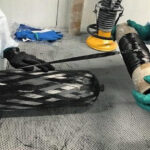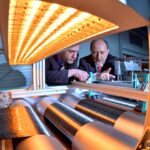Scientists at ASICS Institute of Sport Science in Kobe developed a new CFRTP (Carbon Fiber Reinforced Thermoplastics) technology. In collaboration with a close team of cross-industry partners, they discovered a new usage for composite materials to advance track shoe development.
Traditionally, sprinters have relied on spikes to gain traction. However, by using the new CFRTP manufacturing technology to mold the sole of the METASPRINT™, ASICS have revolutionized the track shoe standards. The new honeycombed carbon fiber outsole removes the spikes to make the traction of the shoe to the track more efficient, so sprinters can exert higher propulsion with every step.
Over short distances, where every millisecond saved count, the METASPRINT™ shoe has been shown to improve speed. Tests conducted by ASICS Institute of Sport Science showed that with this technology, runners were able to go up to 0.048 seconds faster over a 100m sprint.
The challenge to use random fiber composite high-quality thin-walled shoe sole
ASICS employed random fiber composite in this project, because this composite material has a potential to achieve the fine detailed moldability for shoe sole structure. However, manufacturing high-quality thin-walled shoe sole by using current random fiber composite was quite difficult. ASICS team has developed 5 innovative key technologies.
- Precise spreading technology to fabricate ultra-thin tow
- High speed fabrication of high-quality ultra-thin unidirectional (UD) tape
- Uniformly scattering technology of chopped UD tape
- Unique pre-forming technology for any shape of shoe sole
- Appropriate control of fiber length and resin property.
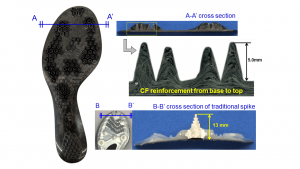
The new technology main characteristics
This new technology makes carbon fiber tow thinner at the thickness of 0.03mm. In-situ polymerizing thermoplastic epoxy is employed as the matrix. As the viscosity of thermoplastic epoxy resin before polymerizing is very low, resin impregnation into spread tow would be quite effective. Furthermore, resin impregnation becomes more effective when our original impregnation technology is employed.
Consequently, void-less and ultra-thin UD tapes can be fabricated at high speed. Void-less and ultra-thin UD tapes are then uniformly scattered and laminated. The pre-form for sprinting shoe sole is automatically manufactured by the unique pre-forming technology. In this technology, the thickness of a shoe sole can be engineered each 20 divided areas with a precision of 0.2g. Furthermore, material waste reduction would be improved in our preforming technology. The fiber length and resin property were also adjusted for manufacturing sprinting shoe-sole structure.
An industry-academia collaboration to realize the project
This innovation has been developed through industry-academia collaboration. The associated partners of the project were Innovative Composite Center of Kanazawa Institute of Technology (Japan), Nagase ChemteX Corporation (Japan) and Suncorona Oda Co. Ltd. (Japan). The product, composite material, and matrix resin manufacturers, and university have challenged to create outside-the- box sprinting shoe. At first, ASICS proposed the unique concept using the carbon-fiber reinforced thermoplastics (CFRTP) mainly based on the conversation with various athletes and scientists. Then the company has designed the sole of sprinting shoe utilizing the parametric designing and finite element analysis. The performance evaluation in terms of athletes’ biomechanical valuables and mechanical properties of the shoe was carried out after prototyping.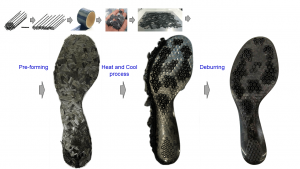
Also, ASICS have been doing wear trial with world-class athletes under various track surfaces and weather conditions. In prototyping, composite material manufacturer developed the CFRTP made from randomly-oriented ultra-thin tape for sprinting shoe. They have adjusted the length of tape for excellent moldability and durability by basic research with university. Matrix resin manufacturer have re-designed glass transition temperature of matrix to prevent sprinting shoes from melting caused by the frictional heat between shoes and ground.
ASICS was announced the winner of the JEC World Composites Innovation Awards 2020 in the Sports and Health care category for this advanced molding technology behind ASICS new spikeless track shoe, METASPRINT™, designed to improve speed over short distance.


